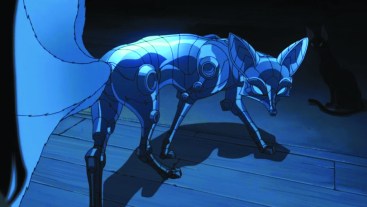‘Love, Death, & Robots’: Different Takes on a Singular Vision
Netflix’s Sci-Fi Series Is Heavy on the Death

The new Netflix sci-fi series amounts to variations on a theme. Titled Love, Death, & Robots, the 18-episode anthology series is heavy on the death and occasionally throws in some love and robots for added spice. Creator Tim Miller (Deadpool) and executive producer David Fincher (Gone Girl) have promoted the series as a celebration of animation, and it plays like a sizzle reel for some of the boldest animation studios of the day. But, while it may be a celebration of human achievement in this narrow respect, Love, Death, & Robots is certainly no celebration of humanity.
For those looking for Fincher’s fingerprints on the project, Love, Death, + Robots’s closest relation would be Fight Club, where reality is susceptible to schizophrenic reordering, and indictments of late-capitalist social malaise are hurled from the privileged vantage of hyper-masculine exceptionalism. Even when the show postures a feminist perspective on the objectification of the female body or the prevalence of violence against women, its insatiable appetite for gratuitously visualizing these ills undermines any softball attempt at critique.

Viewers won’t need to go beyond the first episode, “Sonnie’s Edge,” from Blur Studio, to catch a whiff of the zeitgeist moving through this apocalyptic assemblage. The tech-noir-influenced, photorealist animation is absolutely stunning, and the images dazzle from the outset. But, once the episode has the viewer’s attention, what does it do with it? Under the auspices of a rape revenge narrative and a thin feminist veneer, “Sonnie’s Edge” subjects its viewers to graphic, blood-spurting sexual violence. And when women aren’t having their heads smashed in or aren’t busy penetrating other men and women in phallic retribution, they are completely unable to keep themselves clothed.
Is the standard for cutting-edge technique in animation how realistically it can render a breast? Is there some kind of competition among animation studios with industry-wide metrics on bosom shape and bounce? The nipple count in Love, Death, & Robots would certainly give that impression.

The third episode, “The Witness,” seems to be going for the prize. After a woman accidentally witnesses a scene of domestic violence (cue feminist perspective soon to be obliterated), the assailant gives chase. The woman, whose pigtails and makeup give her an uncanny resemblance to a sex doll, doesn’t quite have enough time to get dressed before needing to escape. With her robe a-fluttering and her breasts and other extremities exposed to the city air, she scampers down staircases and through streets, hails taxis, and makes her way safely to her place of employment: a strip club. The bad guy follows her every step of the way and soon finds himself at her work, where he is treated to a private dance from his would-be victim.
While this strip-show interlude is astounding on a technical level, narratively, the scenario seems to exist solely as an exercise in virtual-reality sex simulation, with an intimate first-person POV as the woman gyrates and touches herself.
Eventually, the chase is back on, and someone dies a grisly death. And so it goes. On and on. Episode after episode.
Victor Maldonado and Alfredo Torres seem to have the distinguished honor of palate cleansers amid all this unsavoriness. They have three episodes in the series, all of which are based on stories by science-fiction writer John Scalzi. Their animation is a little more whimsical, and comedy is more central to their storytelling, but even they can’t resist the appeal of bare, bouncing animated breasts in two out of three of their episodes. And, while Maldonado and Torres may take a more humorous approach, the destructive hubris of humankind and its exploitation of everything possible to exploit, women and resources especially, is never outside their scope.
In one episode, they imagine a super-intelligent yogurt culture taking over the planet. It’s one of the few episodes in the series that is even remotely uplifting. If it sounds strange to consider humanity being eradicated from the face of the earth “uplifting,” maybe watch a few episodes of Love, Death, & Robots first. The apocalypse never looked so appetizing.
Love, Death, & Robots streams on Netflix.




You must be logged in to post a comment.